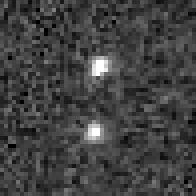88611 Teharonhiawako
 Hubble Space Telescope image of Teharonhiawako and its companion Sawiskera, taken in 2010 | |
| Discovery | |
|---|---|
| Discovered by | Deep Ecliptic Survey |
| Discovery date | 20 August 2001 |
| Designations | |
| (88611) Teharonhiawako | |
| Pronunciation | Mohawk: [d̥ɛhaɺũhjáːɰaɡo] |
| 2001 QT297 | |
| TNO · cubewano[1] cold[2] | |
| Orbital characteristics [3] | |
| Epoch 13 January 2016 (JD 2457400.5) | |
| Uncertainty parameter 3 | |
| Observation arc | 4463 days (12.22 yr) |
| Aphelion | 45.235 AU (6.7671 Tm) |
| Perihelion | 42.454 AU (6.3510 Tm) |
| 43.845 AU (6.5591 Tm) | |
| Eccentricity | 0.031712 |
| 290.32 yr (106041 d) | |
| 158.44° | |
| 0.0033949°/day | |
| Inclination | 2.5834° |
| 304.78° | |
| 236.43° | |
| Known satellites | Sawiskera [zaɰískɛɺa] |
| Physical characteristics | |
Mean diameter | 220+41 −44 km (combined) 178+33 −36 km (primary) 129+24 −26 km (secondary)[4] |
| Mass | 2.445×1018 kg[5] |
Mean density | 1.15+0.87 −0.91 g/cm3[4] |
| 4.7526±0.0007 h[6] | |
| 0.145+0.086 −0.045[4] | |
| 6.00±0.13[6] 5.8[3] | |
88611 Teharonhiawako (provisional designation 2001 QT197) is a trans-Neptunian object and a member of the cold classical Kuiper belt, measuring about 220 km in diameter. It is a binary object, with a large companion named Sawiskera (formally designated (88611) Teharonhiawako I Sawiskera), which at 126 km in diameter is about two-thirds the size of its primary.[7] The two components together are known as the Teharonhiawako–Sawiskera binary system.
Discovery[edit]
Teharonhiawako was discovered on August 20, 2001, by the Deep Ecliptic Survey, and Sawiskera was identified a month later.
Naming[edit]
The primary is named after Teharonhia꞉wako, a god of maize in the Iroquois creation myth, while the secondary is named after his evil twin brother Sawiskera. The objects were named in 2007.[7]
Binary[edit]
Teharonhiawako and Sawiskera is a binary minor planet which orbit each other. Their orbit has the following parameters: semi-major-axis—27670 ± 120 km, period—828.76 ± 0.22 days, eccentricity—0.2494 ± 0.0021 and inclination—144.42 ± 0.35°(retrograde). The total system mass is about 2.4 × 1018 kg.[5]
References[edit]
- ^ Marc W. Buie (2005-07-11). "Orbit Fit and Astrometric record for 88611". SwRI (Space Science Department). Retrieved 2008-09-28.
- ^ Mike Brown's "How many dwarf planets are there in the outer solar system?" "How many dwarf planets are there in the outer solar system? (updates daily)". Archived from the original on 2013-10-15. Retrieved 2018-02-13.
{{cite web}}: CS1 maint: bot: original URL status unknown (link) - ^ a b "JPL Small-Body Database Browser: 88611 Teharonhiawako (2001 QT297)". Jet Propulsion Laboratory. Retrieved 25 March 2016.
- ^ a b c Vilenius, E.; Kiss, C.; Mommert, M.; et al. (2014). ""TNOs are Cool": A survey of the trans-Neptunian region X. Analysis of classical Kuiper belt objects from Herschel and Spitzer observations". Astronomy & Astrophysics. 564: A35. arXiv:1403.6309. Bibcode:2014A&A...564A..35V. doi:10.1051/0004-6361/201322416.
- ^ a b Grundy, W. M.; Noll, K. S.; Nimmo, F.; Roe, H. G.; Buie, M. W.; Porter, S. B.; Benecchi, S. D.; Stephens, D. C.; Levison, H. F.; Stansberry, J. A. (2011). "Five new and three improved mutual orbits of transneptunian binaries" (pdf). Icarus. 213 (2): 678. arXiv:1103.2751. Bibcode:2011Icar..213..678G. doi:10.1016/j.icarus.2011.03.012.
- ^ a b Vilenius, E.; Kiss, C.; Mommert, M.; et al. (2014). ""TNOs are Cool": A survey of the trans-Neptunian region VI. Herschel>/PACS observations and thermal modeling of 19 classical Kuiper belt objects". Astronomy & Astrophysics. 541: A94. arXiv:1204.0697. Bibcode:2012A&A...541A..94V. doi:10.1051/0004-6361/201118743.
- ^ a b Wm. Robert Johnston (6 May 2007). "(88611) Teharonhiawako and Sawiskera". Johnston's Archive. Retrieved 2008-09-28.
External links[edit]
- 88611 Teharonhiawako at AstDyS-2, Asteroids—Dynamic Site
- 88611 Teharonhiawako at the JPL Small-Body Database
